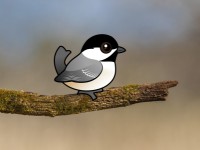Warbler Week: The Stories Behind the Names
Several warblers are named for their beautiful plumage, like the Black-throated Blue Warbler, Golden-winged Warbler, and Chestnut-sided Warbler. But many warblers are named for other traits, including habitat types and physical locations, which may or may not be accurate. Others are named for the naturalists who first discovered them or described them for science. Here are some stories behind the names of some New World warblers.
Sometimes it's not obvious that a warbler is named for its plumage. Cerulean Warblers are named for their color - cerulean blue is close in shade to azure and sky blue. Several other birds are named for this color, including the Cerulean Kingfisher of Indonesia and the Cerulean-capped Manakin of Peru. The Flavescent Warbler is named for its yellowish, flavescent, color. The Prothonotary Warbler is supposedly named for the golden robes worn by prothonotaries, high-ranking clergy in the Roman Catholic Church. The Mourning Warbler is named for the male's dark hood, which was thought to resemble a mourning veil. And earlier on the blog, in a separate post, we told you the story behind the name of the American Redstart.
The Blackburnian Warbler was named for the English botanist and naturalist Anna Blackburne. The Blackburnian Warbler was actually first classified by the German zoologist Philipp Ludwig Statius Mueller, who named the warbler in Anna Blackburne's honor. Blackburne also has a species of beetle named in her honor.
Kirtland's Warbler is named for the amateur naturalist Jared P. Kirtland, a doctor and politician from Ohio. Kirtland was interested in natural history and was involved in the first geological survey of Ohio. Besides the endangered warbler, Kirtland also has two species of snake named after him.

The Worm-eating Warbler, like most species of warbler, feeds on a variety of different insect prey items, including worm-like larvae. They are not unique in this diet and feeding strategy, and they rarely or possibly never eat earthworms.

The Ovenbird is named for the shape of its nest. Ovenbirds make a domed structure, known as an "oven", on the ground. The dome is made of woven vegetation and has a side entrance.
Wilson's Warbler was first described for science in 1811 by Alexander Wilson. Wilson has been called the "Father of American Ornithology." He published a nine-volume study of American birds between 1808 and 1814, describing at least 26 new species. Several other species are named for Wilson, including a plover, a snipe, and a phalarope.

Sometimes a warbler's name doesn't make a lot of sense. For instance, the Magnolia Warbler is named for a type of tree it only encounters for a short time, if at all, each year. The ornithologist Alexander Wilson first saw this species of bird in a Magnolia tree in Mississippi during migration. The type of tree was likely Magnolia grandiflora, a species native to the southeastern United States. Magnolia Warblers only pass through this range while migrating between their northern breeding grounds and their wintering grounds in the Caribbean and Central America.
Similarly, the range of the Nashville Warbler only brings them around Nashville, Tennessee, during migration. It's the same story for the Tennessee Warbler, which was named from a specimen collected in Tennessee during migration. At least the Kentucky Warbler breeds in Kentucky, though its breeding range extends further afield.
Whether the name makes sense or not, we love all warblers! Thanks for following all during our Warbler Week, and stay tuned for more warbler fun in the coming days.





Comments
Leave a comment
Thank you!